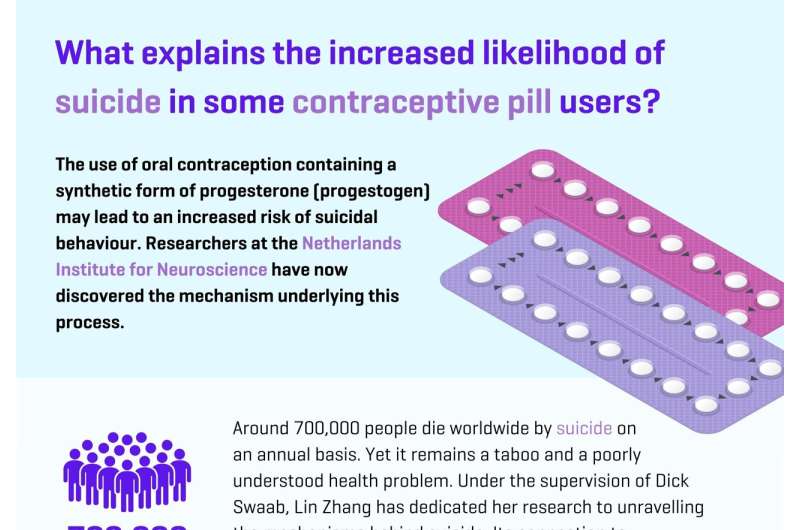This article has been reviewed according to Science X's editorial process and policies. Editors have highlighted the following attributes while ensuring the content's credibility:
fact-checked
trusted source
proofread
Newly discovered mechanism explains heightened risk for suicidal behavior among some contraceptive users

The use of oral contraception containing a synthetic form of progesterone (progestogen) may lead to an increased risk of suicidal behavior for women with depression and suicidal ideations. Researchers at the Netherlands Institute for Neuroscience have now discovered the mechanism underlying this process.
Around 700,000 people die worldwide by suicide on an annual basis. Yet it remains a taboo and a poorly understood health problem. Under the supervision of Prof. Dr. Dick Swaab, Dr. Lin Zhang has dedicated her research to unraveling the mechanisms behind suicide. Its connection to progesterone became her latest research target.
Progesterone plays a role in women's reproductive systems but can also act as a stress hormone. The latter is often neglected. "All stress-related substances may contribute to suicide risk," Swaab explains. "Because of its link to stress, depression, and suicide, we wanted to learn more about how progesterone impacts the brain."
Zhang was able to study brain samples obtained through the Netherlands Brain Bank, ranging in age, sex, diagnoses, and causes of death. Her research showed that the lower part of the hypothalamus, known as the infundibular nucleus, is most sensitive to progesterone. This became the focus point of her research.
In patients with depression who died as a result of suicide, Zhang found an elevated number of cells producing an opiate-like substance. This increase was contributed by the fact that they co-expressed the progesterone receptor.
Swaab says, "It is known that taking opiates increases the risk for suicide. The brain is sensitive to opiate-like substances because it also makes those substances itself. So progesterone likely increases the activation of the opioid system, eventually leading to heightened suicidal risk."
An additional notable observation by Zhang was that signs of cell division appeared in the infundibular nucleus of aged population. The generation of newborn neurons in the adult human brain, especially in the elderly, is still a topic of debate among neuroscientists.
Progestogen-containing drugs are frequently prescribed as contraception or for the treatment of menopausal complaints. Clinical research shows that, while the risk for suicide is negligible in drugs containing natural progesterone, this may not the case for its synthetic form, as it is more potent.
Gynecologists have incorporated this knowledge into their standard practice by screening patients for depression and suicidal risk before prescribing one or the other. This is not yet the case for general practitioners. "We hope this finding will cause doctors to explicitly ask for signs of depression or suicidal ideations and, if necessary, suggest an alternative option."
The findings are published in the journal Acta Neuropathologica Communications.
More information: Lin Zhang et al, Progesterone receptor distribution in the human hypothalamus and its association with suicide, Acta Neuropathologica Communications (2024). DOI: 10.1186/s40478-024-01733-y




















